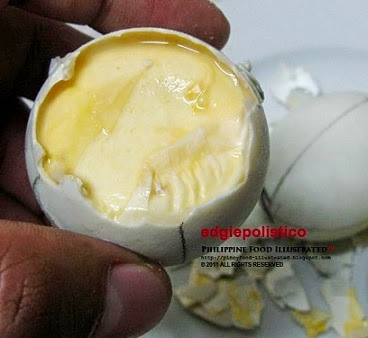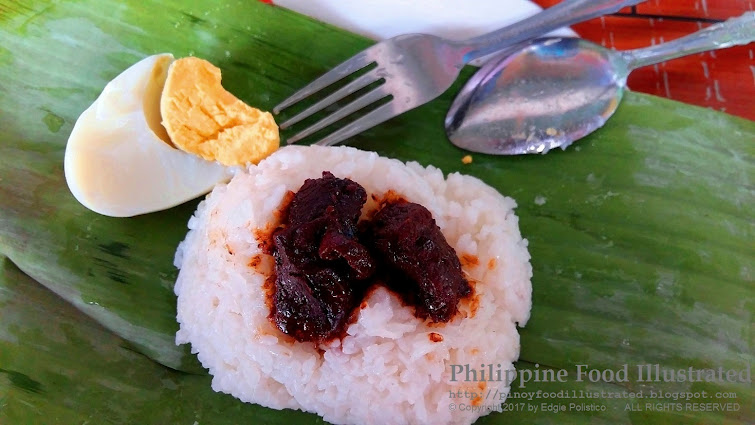 |
Etag from Sagada, prepared by the Igorots of Sagada, Mountain Province. |
etag – /é-tag/ Ilocano and Cordilleran [Ifugao, Igorot, Kankanaey] preserved meat [n.] cured and aged slab of pork; An indigenous smoked or sun-dried salted slab of pork.
Other local common names:
- also spelled as itag in IIocano
- a.k.a. innasin in Ilocano
Etag is the general term used in Cordillera about the native’s traditional way of preserving pork. A slab of a big slice of pork is cured in salt for about a week (or longer) then air-dried under the sun or smoked for several weeks (even months), or both. Though any kind of wood will do the smoking, the Igorots would prefer to use the wood from a tree they called alnos as it would emit pleasant smoke and add an aromatic smoky flavor to the meat. If alnos is not available, wood and leaves of guava trees are said to be a good substitute.
For the locals, the longer the etag is cured in salt and air-dried, the more it is tasty, flavorful, and expensive when sold in the market. The meat would turn darker and darker in color over a long time during the aging process.
Etag may not be appealing to the uninitiated because it has a foul odor and most often has maggots after several days of air-drying the meat, probably because of its exposure to flies. As it undergoes the aging process, etag is often covered on the surface with a thin layer of milky-white molds similar to when aging cheese. The molds are rinsed off and etag is safe and ready to cook.

This etag from Sagada is partly covered in the middle with white molds over few weeks of aging. This one was prepared by the Igorots of Mountain Province.
The cured meat is grilled and served with cooked rice. It is also used as a meat ingredient in some native vegetable dishes, or boiled in a soupy broth with pinikpikan (chicken that was beaten slowly to death).
When necessary, etag has to be soaked for a while in plain water and then rinsed thoroughly to reduce its saltiness.
Etag has to be consumed after a week of drying or smoking. When there is extra etag, it must be stored in a closed container to avoid the infestation of flies and their maggots, ants, cockroaches, and other insects and even from rodents. If stored longer, it has to be sun-dried or smoked again from time to time and avoiding it getting wet or moistened with too much moisture. Hanging the etag right above the smoking kitchen stove when they cook their meal is also a common practice done by the natives when storing and continuing the aging process.
In Mountain Province, the natives and the local government mounted their annual celebration of the Etag Festival for their favorite preserved meat. It is held every February.
Depending on how the aging process was done, etag is generally classified as "smoked" or "sun-dried," as follows:
smoked etag (es-mok e-tag; Cordilleran preserved meat) [n.] a kind of etag that is smoked to further preserve the cured meat. Thus, it is referred to as the "smoked ham" of Cordillera. Smoking is usually done by hanging the etag over and close to the stove or hearth, exposing the cured meat to smoke while being air-dried. The fast way to smoke etag is to build fire on a pile of firewood and place the skewered etag close to the fire but not too close that it would get roasted instead of being just smoked. It is done at least 30 minutes every day for a week and the meat must be kept in a sealed container after each smoking session to avoid the infestation of flies and their maggots. Smoked etag has a dark reddish-brown color because of the stain caused by the smoke.
sun-dried etag (san-drayd e-tag; Cordilleran preserved meat) [n.] a kind of etag that is sun-dried to further preserved the cured meat. It is air-dried under the heat of the sun by skewering the cured meat in a long stick and hang on a stretched rope or clothesline, or simply spread on flat dry surface, such as on concrete structure, big rocks, or on trellis-like frame of bamboo sticks, like those used in drying fish. It is then turned over from hour after hour to equally dry the other side. Sun-dried etag is lighter in color compared to smoked etag due to lack of staining. It would more likely that flies and their maggots would infest the meat if it is not protected with screen or net while in the process of sun drying.
 |
These etags are air-dried under the sun somewhere in the public market of Bontoc, Mountain Province and was described as the "Bontoc ham" by Phil. Daily Inquirer on its Dec. 21, 2009 issue, as the processed meat is often regarded as the region's version of Christmas ham. (Photo credit to Espiritu of the Phil. Daily Inquirer (Northern Luzon).) |
The etag may also be prepared using both curing processes. That is, the meat is cured first by smoking and then sun-dried in the next few weeks or months that follow.
Nowadays, the Cordillerans (Igorot, Ifugao, Kankanay, and other ethnic tribes of Benguet and Mountain Province) would commonly use pork from cultured or farmed pigs to make etag. In the past, when the forest of Central Luzon was abounding with wild animals, the natives would hunt wild pigs and wild deer and use the pork of wild pigs and venison of wild deer in making etag. The most coveted and highly valued etag is venison.
Personal notes:
With due respect to the customs and traditions of all the ethnic groups of Cordillera and northern Luzon, the process of making etag and how long the aging process would take to complete reminds me of the Fire Mummies (a.k.a. Kabayan Mummies) of Benguet. The mummification process of fire mummies was unique compared to on how mummification was done in Egypt and the rest of the world. It was like the natives were preserving their dead in a process similar to when making an etag. The mummification would begin right after a person died, whom they would let ingest a very salty drink. The corpse was washed and set over a fire in a seated position to dry out bodily fluids. The dead were also subjected to the smoking process. Tobacco smoke was blown into the mouth to dry further the inside of the body including the internal organs and then herbs were rubbed into the body before the mummified body was placed in a coffin of dugout pinewood and laid to rest in rock shelters, caves, or burial niches.
This mummification process of Cordillera ended in the 16th century when Spain started its colonization of the country, but the practice of making etag persisted for centuries, even to these days. The people of Mountain Province conserved this ancient traditional meat delicacy and promoted it by mounting an annual celebration of the Etag Festival every February.
All photos by Edgie Polistico are copyrighted. ALL RIGHTS RESERVED.
Thank you for the encouragement and enthusiasm. I also need your moral support, prayers, and anything else that can uplift my spirit and keep my good reasons. Keep them coming. Sharing with and giving away is happiness to me. If you are pleased and happy with what I am doing, just smile and share with the happiness we have in the PHILIPPINE FOOD ILLUSTRATED. I feel energized every time my blog becomes one of the reasons why you are happy and smiling.































